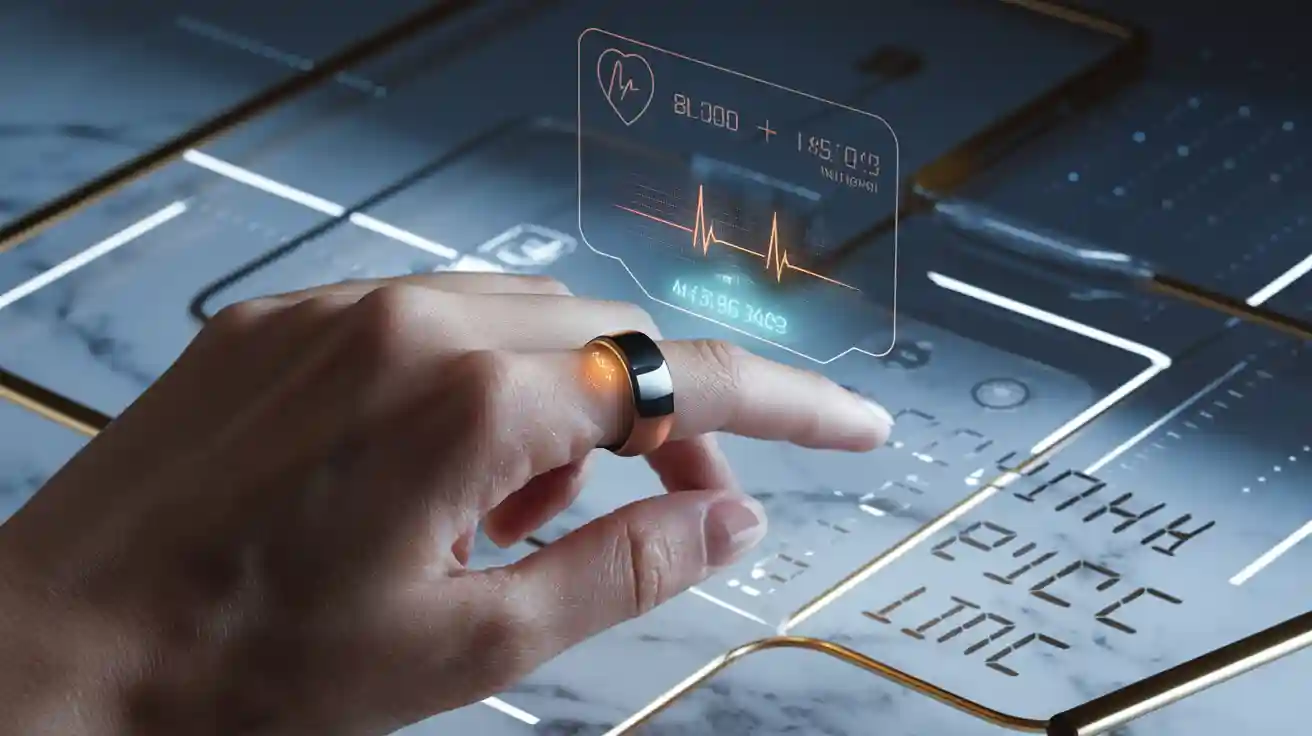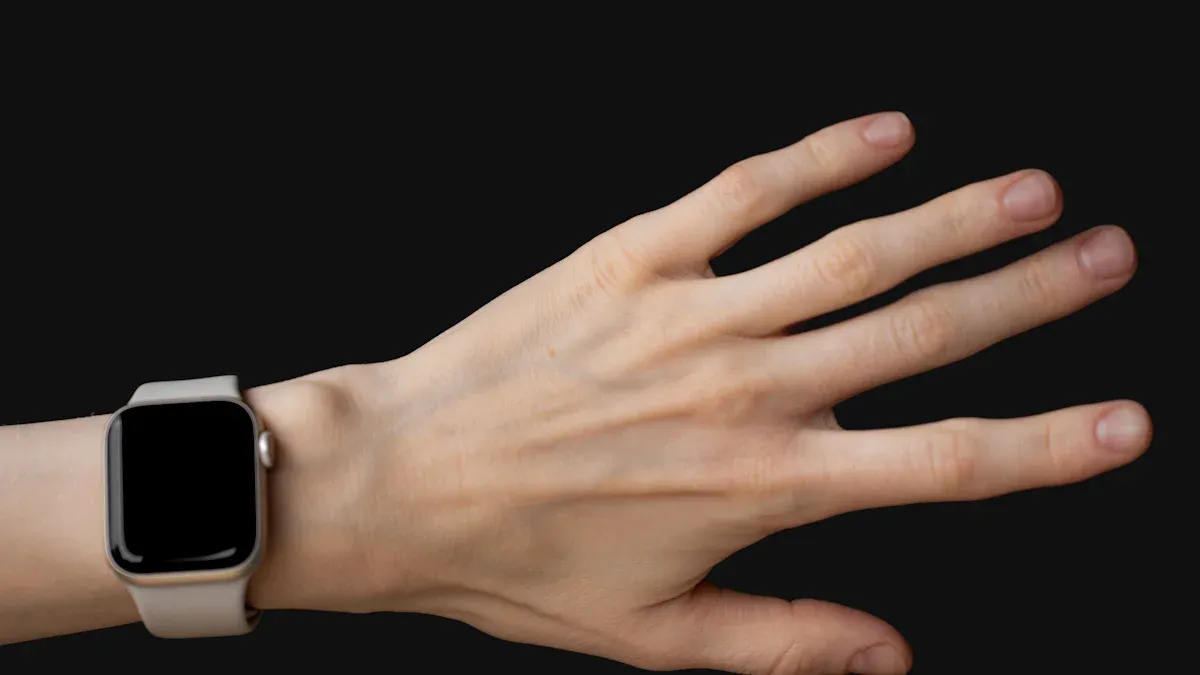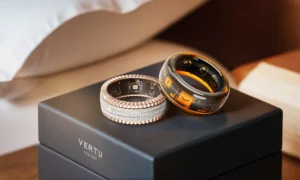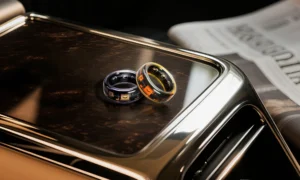
A smart ring that tracks blood pressure helps you monitor your health daily. These small devices utilize advanced technology like PPG sensors and smart AI to provide instant updates. Studies indicate they are highly accurate, with a strong correlation of 0.81 between ring readings and traditional blood pressure tests. Key findings include:
-
Minimal errors for systolic (0.11 ± 5.27 mmHg) and diastolic (0.11 ± 3.87 mmHg) readings.
-
Over 2000 data points analyzed across various blood pressure levels (systolic: 89–213 mmHg, diastolic: 42–122 mmHg).
Smart rings that track blood pressure combine functionality and elegance, making them a revolutionary health tool for everyday life.
Key Takeaways
-
Smart rings check blood pressure accurately with tools like PPG sensors and AI. They make health tracking simple and handy.
-
These rings give quick updates about heart health. This helps people make better choices and take care of their health.
-
Smart rings are comfy and look nice. They are better than regular blood pressure cuffs and can track health all the time without causing pain.
How Does a Smart Ring That Tracks Blood Pressure Work?
The Role of Pulse Transit Time (PTT) in Blood Pressure Monitoring
Pulse Transit Time (PTT) is key to how smart rings work. PTT measures how fast blood moves between two body points. This speed depends on artery stiffness and blood pressure levels. By studying PTT, the ring estimates blood pressure without needing a cuff.
For instance, the Circular Ring 2 uses PTT to track blood pressure all day. It measures how quickly blood flows through arteries. This helps you see how your habits affect heart health. Research shows PTT is a good way to track blood pressure changes. One study found toe pulse arrival time (PAT), a type of PTT, matched well with systolic blood pressure. This proves PTT helps make cuffless monitoring more accurate.
Photoplethysmography (PPG) Technology and Its Functionality
Photoplethysmography (PPG) is another important technology in smart rings. PPG uses light to check blood volume changes in your vessels. The ring shines light on your skin and measures how much is absorbed or reflected. This data helps track heart rate and blood pressure.
PPG in smart rings has improved a lot. These rings use reflectance PPG with many sensors and lights. This setup measures light from oxygen-rich and oxygen-poor blood. It gives accurate, non-invasive results. Below is a table showing advanced PPG features in wearables:
|
Feature |
Description |
|---|---|
|
ECG-calibrated accuracy |
Matches electrocardiogram standards for better accuracy. |
|
Proprietary motion artifact elimination |
Filters out noise caused by movement. |
|
Multi-sensor data fusion |
Combines data from different sensors for better tracking. |
|
Real-time signal processing |
Analyzes and shares health data instantly. |
|
Enhanced motion artifact elimination |
Removes interference from movements effectively. |
|
Advanced signal processing |
Uses smart methods to clean up data. |
|
Breakthrough in oximeter limitations |
Fixes common problems with wearable pulse oximeters. |
These features make smart rings reliable, even when you're moving or in tough conditions.
Integration of AI and Advanced Sensors for Accuracy
Smart rings use artificial intelligence (AI) and sensors to improve accuracy. AI studies data from PTT and PPG sensors to monitor blood pressure. Over time, the device learns your health patterns, making it more accurate and personal.
For example, the CAR-T ring tracks blood pressure in real time. In a study, it showed lower readings when awake. During sleep or stress, its results matched traditional cuffs. This shows AI and sensors adapt to give accurate readings.
The Vertu AI Diamond Ring – Galaxy Edition is a great example. It has a precise PPG sensor chip and AI Health Guard. These tools provide constant, non-invasive heart health tracking. With these technologies, the ring gives accurate health updates, helping you stay healthy.
Benefits and Limitations of Blood Pressure Monitoring with a Smart Ring
Advantages of Using a Smart Ring for Health Tracking
A smart ring has many benefits for tracking health. Its small size makes it easy to wear all day. You can check your health without using bulky devices. Unlike cuffs, it tracks blood pressure without causing discomfort. This is helpful for people who need regular heart health updates.
Here are some main benefits of smart rings:
-
In 2024, 43.73% of smart ring sales will be for health use.
-
They track heart rate, sleep, and activity all the time.
-
Apps give you tips based on your health data.
These features make smart rings great for managing health. They give real-time updates, helping you make better lifestyle choices.
Challenges in Accuracy and Usability
Smart rings are advanced but have some problems. Their accuracy can change due to skin tone or movement. For example, moving too much during exercise may affect sensor readings. New tech like motion filters and better sensors help fix this.
Comfort is another issue. Some people may not like wearing a ring all day. Also, charging the ring often can be annoying. Still, many people find cuffless blood pressure tracking worth these small issues.
Suitability for Different Users and Health Conditions
Smart rings work for many people, even those with health problems. They track heart rate, temperature, and oxygen levels all the time. This helps spot health issues early, which is useful for heart patients or others with medical needs.
For people with long-term illnesses, smart rings can be very helpful. They let you see your health stats instantly and stay informed. But remember, smart rings don’t replace doctors. Always talk to a healthcare expert for medical advice.
Comparing Smart Rings to Other Wearable Devices

Smart Ring vs. Smartwatch for Blood Pressure Monitoring
Smart rings and smartwatches both help track your health. However, they are different in design and use. A smart ring is small, stylish, and easy to wear all day. It doesn’t feel heavy or bulky. Smartwatches are bigger and have more features like fitness tracking and notifications.
Smart rings are better at measuring blood pressure. They use advanced tools like PPG and Pulse Transit Time for accurate results. Smartwatches also use these methods but may not work well during movement. If blood pressure tracking is your main goal, a smart ring is a better choice. It is more focused and convenient.
Smart Ring vs. Traditional Blood Pressure Cuffs
Traditional cuffs are the old way to check blood pressure. They give accurate results but can be hard to use often. They need to be operated manually and can feel uncomfortable. Smart rings solve these problems by offering easy, non-stop monitoring.
Smart rings collect data all day. This shows how your blood pressure changes with different activities. The real-time data helps you learn about your heart health. Cuffs are still important in hospitals, but smart rings are great for daily use. They are perfect for tracking long-term trends.
Key Factors to Consider When Choosing a Health Monitoring Device
Think about your lifestyle and goals when picking a health device. Here are some tips to help:
-
Decide your health goals, like improving heart health or tracking activity.
-
Choose features you need, such as blood pressure or sleep tracking.
-
Compare devices for comfort, accuracy, and ease of use.
The table below shows features of different health devices:
|
Type of System |
Features |
|---|---|
|
Smartwatches |
Tracks health, gives alerts, shows weather, and has GPS. |
|
Wearable rings |
Tracks blood pressure, heart health, and looks stylish. |
|
Traditional cuffs |
Accurate readings, manual use, best for medical settings. |
Pick a device based on what matters most to you. If you want style and ease, a smart ring like the Vertu AI Diamond Ring – Galaxy Edition is a great choice.
Smart rings are changing how we monitor our health. They give quick updates, making them very useful.
📊 Trends to Watch:
Health tracking tools are improving fast.
Wearable devices are becoming more popular.
Telemedicine features make them even more helpful.
These advancements make smart rings important for managing your health.
FAQ
How accurate are smart rings for blood pressure monitoring?
Smart rings use advanced sensors and AI to give precise results. Research shows their readings match well with traditional cuffs. This makes them dependable for checking your health every day.
Can you wear a smart ring while swimming?
Yes, you can! Many smart rings, like the Vertu AI Diamond Ring, are waterproof. They are safe to wear in the shower or while swimming.
💡 Tip: Always confirm your smart ring’s waterproof rating before using it in water.
How long does the battery of a smart ring last?
Most smart rings, such as the Vertu AI Diamond Ring, have long-lasting batteries. They can work for up to 10 days on one charge.
🔋 Note: Battery life depends on how often and which features you use.







